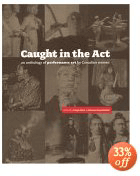Caught in the Act: An Anthology of Performance Art by Canadian women

by Edited by Tanya Mars and Johanna Householder
444 pages,
ISBN: 0920397840
Post Your Opinion | | Performance Art and its Troupers
by John Oughton
Confession: I was a women's performance art groupie.
Conflict of Interest: I participated, tangentially, in some of the performance pieces discussed in the book, contributing a title here, photographs there, occasional music, words, even appearing myself as a moving prop.
Proposition: The eclectic and often poorly-documented work by women falling into the category "performance art" from the early 1970s to late 1990s was the most vital and original development Canadian art has seen in a long time. It was also, arguably, the most entertaining and (often) effective form that feminism has found to present its insights in this country. The rise of Canadian nationalism, the beginnings of a grant system for non-traditional art, and the emergence of artist-run centres sympathetic to experimental work all helped the growth of the art documented here. For a long time, there was little documentation of Canadian performance art generally, but an initial survey book by Clive Robertson and FADO's series on individual artists began to fill the gaps, and this book adds a valuable study of women's contributions.
Definition: What is "performance art" anyway? The editors of this valuable anthology don't provide a succinct explanation. It is an action or series of actions in which the artist is physically present, and which draws from multiple genres and media including dance, theatre, comedy, pop culture, music, the visual arts, and literature. Good performance art is by its nature unpredictable, and the audience may become involved as more than spectators. Performance art has roots in the impromptu performances of Dadaists, in political and agitprop theatre, in burlesque, happenings and conceptual art. To see a new work by Canadian artists like Margaret Dragu, Elizaabeth Chitty, Lily Eng, Rebecca Belmore, or Artifacts (Pam Patterson and Leena Raudvee) was to launch yourself into the unexpected. It could be a striptease, a provocation, an assault on the walls, or a cooly minimal dissection of what happens when artists move through the audience. It also questioned, either subtly or overtly, one's image of the female body in performance, shifting it from traditional notions of the decorative, feminine or elegant to more risky and less limiting possibilities. You might encounter blenders, aprons, or laundry in women's performance-but they would be used in rather new ways.
Editors Tanya Mars and Johanna Householder are themselves important contributors to the growth of Canadian women's performance art, both solo and with collaborators. Tanya Mars created the memorable works Pure Virtue and Pure Vice, and Householder was a member of the (in)famous feminist lip-sync group the Clichettes. Now that both teach performance art, they realized that no text existed that adequately represented the works and performers they discussed. They commissioned a series of five general articles on issues like the body in performance and the role of costume, and more specific profiles on 34 individuals and groups they felt constitute the "canon". Frequent and often striking photographs, including a small colour portfolio in the final pages, add a visual dimension to the words.
This book is essential. For those of us who attended some of the performances described, it recalls the laughter, surprise, and (sometimes) alarm evoked by them; for those who because of their age or location were unable to be there, it gives a sense of just how eclectic, genre-blurring and ambitious the performances, and performers were. Many of the articles strike a good balance between description, interpretation, and insight, while avoiding overuse of the tiresome "art" vocabulary that obscures more than it reveals. It is also a well-designed book, its a square format using relatively narrow text columns that allow room for marginal notes and illustrations.
Nonetheless, there are some frustrations and puzzling choices made. It lacks an index, which will irritate any serious student; many of the performers mentioned in this book worked with each other, trading influences through collaboration, yet you can't reliably track those collisions here. Another useful addition would have been a chronology or time line, beginning with the earliest works mentioned in the book, so that the stages in the developing performance scenes in Montreal, Toronto, and Vancouver can be viewed simultaneously. The choice of subjects for the profiles is also an issue: Lillian Allen, while undeniably a powerful performer as a dub poet, is not, strictly speaking a performance artist like the others profiled here. If performance poetry is to be included, Penn Kemp should be profiled as well.
But, despite those caveats, this book belongs on the shelves of those who care about experimental and performance work. It commemorates a lot of striking and quirky work by many women who invented new ways to make audiences lose their preconceptions and see what women, and women's bodies, are capable of.
John Oughton sacrificed his first car, a 1966 Rambler, to a performance art piece at 15 Dance Lab.
|